Family : Lycaenidae

Text © Dr. Gianfranco Colombo

English translation by Mario Beltramini
We often do not realize how it can be easy to cause irremediable damage to the nature and compromise irredeemably the balance of an ecosystem that the natural selection has built in millennia of evolution, with actions that may seem insignificant but reveal later on inexorably their harmful effects. The introduction of allochthonous species in an environment differing from that where they have originated, has invariably had disastrous effects. The area is easily occupied as the new species does not find in loco any natural enemy that knows it and hence the alien has a good game in prevailing and developping in extremely short time.
It is obvious that not all the species may survive to this initial trauma, taking logically into account that tropical species will never be able to live in opposite climates or vice versa the boreal ones but when an acclimatization is possible, here it is that the problem gets apparent. We could list tens of alien species that have invaded other territories due to the man even if some of them are fruit of introductions rightly wanted by him, with the foolish goal of finding foreign enemies to fight local enemies but often this invasion is fruit of the human silliness and of his misbehavior.
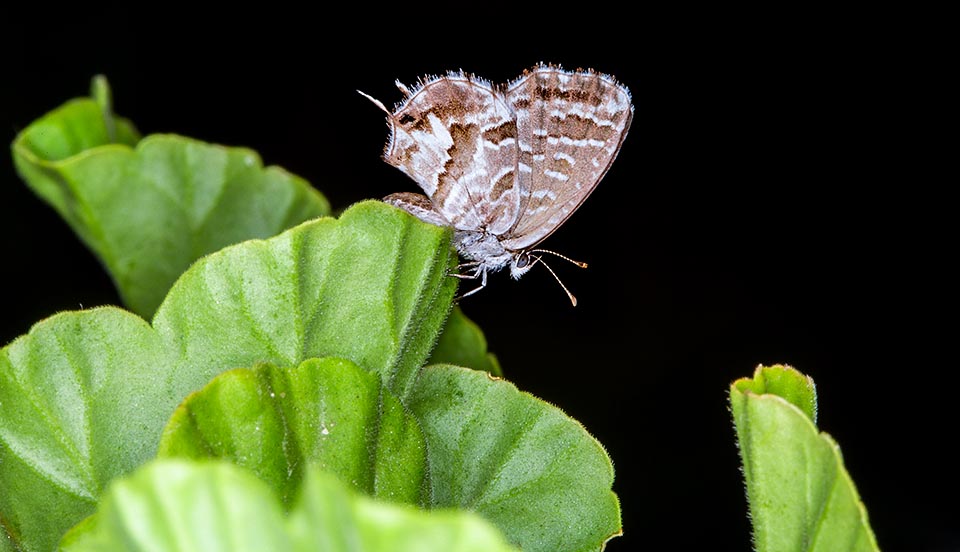
Cacyreus marshalli is a graceful and seemingly innocuous small butterfly, of 20-25 mm of wingspan, native to southern area of the African continent © Giuseppe Mazza
All compartments of nature have been interested without exclusion of blows and without any distinction and still now is present a deliberate underestimation of the problem. Unluckily, besides the senseless introduction due to direct man’s actions, other species have reached the new territories through much more sneaky ways, exploiting those modern channels that now see international commercial exchanges with means of transportation so fast to relieve those natural trauma that long distances, temperature changes and long periods, could affect the vitality and the survival of these beings. An invasion that has seen the arrival of more than 150 alien species during the last 15 years.
One of these, even if seemingly is a graceful and harmless small butterfly, is the Geranium bronze (Cacyreus marshalli Butler, 1898), belonging to the order of Lepidoptera and to the family of the Lycaenidae, a present come to us from the extreme south of the African continent that, in addition to delight ourselves with its fast and coloured flight, is capable to destroy quickly entire cultivations of these very common flowers and, even more easily, the pots that we, with a lot of care, keep on our balconies.
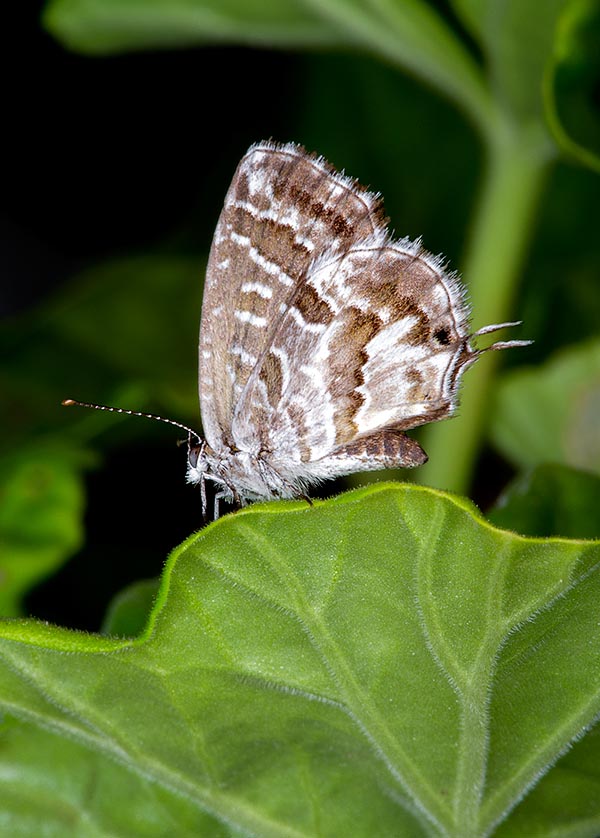
Unfortunately, it eats Pelargoniums, the geraniums of gardens, terraces and balconies of most Europe © Giuseppe Mazza
The entrance door of this invader seems to have been Spain by the end of the years ’80 that has signaled it at the Balearic Islands first and then, immediately afterwards, on the continent, albeit almost at the same time other sightings have occurred all over the European Mediterranean area. Of course, and as easily has been discovered, vehicle of this one as well as of other invasions has been a stock of infected pelargoniums imported from South Africa that contained most likely eggs or larvae of this butterfly. It is difficult to think that an adult specimen already imago has survived hiding among the branches of this flower during the voyage.
Extremely eased by a climate rather similar to the original one and also by a same latitude, this butterfly has not found any difficulty in adapting and in developing with a speed to say the least anomalous. Furthermore, the cultivated geranium or in general the pelargoniums, are flowers standing among the most common and diffused all over Europe and even more in the Mediterranean area where it has contributed to develop and consolidate the first stump strengthening it strongly since the first years.
The etymology of the scientific name is not defined for the genus Cacyreus, term that does not get any valid reference seen that Cramer himself, classifier of this genus, as he has well evidenced in Proc.zool.Soc.London year 1897 page 845, declares that already pre-existing in the naturalistic taxonomy, the genus Hyreus, assigned to a group of birds he would have liked to use in classifying this small butterfly, in order not to create confusion has practically invented the name of the genus Cacyreus. Furthermore, also the year of nomenclature is not always rightly interpreted as several texts propose Butler, 1897 instead of 1898.
Conversely, for the species marshalli the etymology is clear, referring to Sir Guy Anstruther Knox Marshall, very well known entomologist of the end of the XIX century who operated between India, South Africa and United Kingdom. The vulgar names given in Europe get back unavoidably to the attachment this lepidopteran has for this particular type of essence. In Spanish, Mariposa del geranio, in German Pelargonien-Blaüming, in French, Brun des Pélargoniums, in English Geranium Bronze, in Dutch Geraniumblauwtje and in Italian Licenide dei gerani.
Zoogeography
This lepidopteran is typical to the southern area of the African continent, with a range including Mozambique, South Africa, Botswana and Zimbabwe. It is possible, however, that its range is much more extended and may include also Namibia and perhaps northwards, to overcome the course of the Zambezi River and the Cubango (Okavango) River westwards following those dry and arid environments so much appreciated by this lepidopteran.
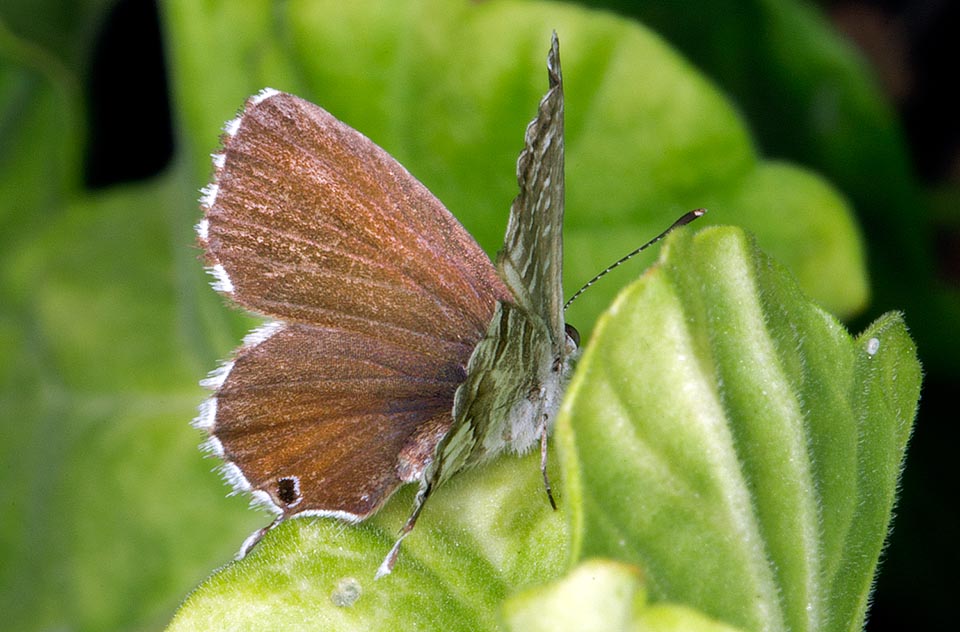
In South Africa it had no predators, but with us, arrived in Spain by the end of the ’80, it has no foes with such a similar climate, at times even better © Giuseppe Mazza
Nowadays in Europe it is diffused in all the continental part with very numerous populations in the Mediterranean area but continuously progressing northwards, helped by the climate changes underway that are leading the temperatures of Central and Northern Europe to often further. In our continent it is presently relegated to the only western part of the territory leaving almost completely clear the eastern part probably due to an actual climate difference during the winter season. The Scandinavian peninsula and England are not at the moment occupied if not accidentally. It is however important and determinant in this conquest journey, the presence now diffused of the cultivation of the geraniums which is their means of transportation for new conquests.
Ecology-Habitat
The Cacyreus marshalli is a lepidopteran living in very sunny environments, basically dry, where its host plant grows and easily reproduces. In its origin habitat it is found on hilly areas with bushes and low vegetation, in sparse thickets with ample grassy spaces not disdaining the presence of water streams but absolutely avoiding the dense forests and highly treed zones.
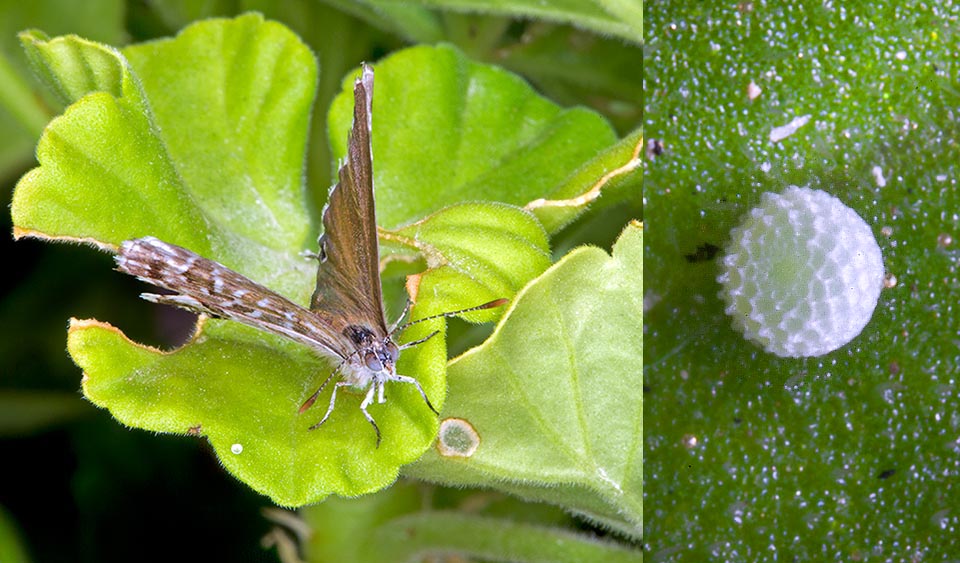
With its 4-10 weeks reproductive cycle, depending on the temperature and the humidity of air, during the summer can easily reproduce generations continuously for various months. Here we note a tiny abandoned eggshell, on the leaf left to the butterfly, and the enlargement, on the right, of an egg just laid with its typical pattern © G. Mazza
As for all allochthonous species, the new ecosystems have initially faithfully traced the characteristics of these original environments even if, actually, the whole is conditioned more directly by the presence of the host plant than by the conditions of the new habitat. These invasive species try to organize themselves with any means to the new environmental conditions often facing even rapid revolutions of their own biology, in the attempt to better adapt to the new situations. There would be no wonder in hypothesizing even an extension of the number of the host plants.
Morpho-physiology
The geranium bronze is a very small butterfly that often gets unobserved due to its quick flight, its not lively colour and of course for the reduced size. Where present, is very common and persistent seen the prolificacy and is visible for many months during the summer season. It has little more than 20 mm of wingspan with peaks over the 25 mm in some females. It does not have the usual sparkling colours typical of the lycaenids missing of the typical light blue colour as well as of the bronzed or of the green of our most common species and therefore it is relegated among the brown and without evident sexual chromatic dimorphism lycaenids.

After a few days, less than one week from the deposition, the newborn larva digs immediately a small hole in the stem of the geranium and begins to eat the inner part, morbid and juicy. Then, growing, punches the stem and gets out in the evening to chew the leaves. The big hole, well visible here, is the irrefutable sign of the infestation © Giuseppe Mazza
The upper face of the wings is greyish brown, bordered by a slight fringe on the margins, with small alternating white shades. It has two tiny tails on the hind wings that elongate almost invisibly of a couple of millimeters and that easily escape a quick observation. At the base of these tails stands a small blackish spot that, in correspondence, clearly transpires also on the lower face. Conversely, the lower face of the hind wings is very mottled, with clear whitish stripes that cross the whole wing on a greyish hazel colour that creates variegated and indefinite marblings. They are however identifiers of the species that may be mistaken with other quite similar autochthonous varieties.
Being of fresh appearance in out territories, this lycaenid is monospecific as it appears in the origin locations, not clearly displaying geographical or local morphological characteristics such to hypothesize possible subspecies. In Europe it can be easily mistaken with some lycaenids with whom it shares the conquered territory such as the Lampides boeticus and the Leptotes pirithous both with the same size and with analogous drawings on the back faces of the wings.
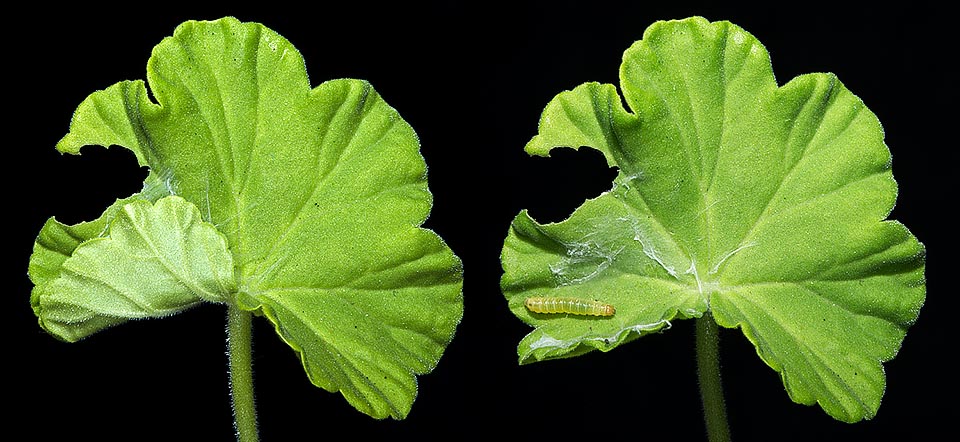
In the end however the caterpillar is tired and builds a spacious aerial house where to spend the day hours. Taking advantage of the meal it isolates a zone of the leaf and pulls it with the silk to bend it on itself. It’s the case of the image on the left of the photo, whilst on the right, opening it we discover the small scared landlord © G. Mazza
Ethology-Reproductive Biology
What we can see in the new occupied territories evidences that this lycaenid is overwhelming the reproductive situation that it maintains in the origin locations.
Not having at the moment in Europe evident natural foes and finding climate situations rather favorable during the good season but even more, taking advantage from a remarkable and diffused presence of the host plant, this small butterfly can reproduce in an exasperated way thus consolidating more and more the bridgehead of its now victorious invasion.
The geranium bronze has a reproductive cycle varying from 4 to 10 weeks, depending on the temperature and the humidity of the air, hence during the summer it can easily be able to produce generations continuously for some months.

The caterpillars growth is very fast. Here a now big specimen, ready to pupate in its aerial house © Giuseppe Mazza
Direct indications of this proliferation are of course the number of pots of geraniums that we must replace in our flowerpots as the damage is a direct consequence of the number of specimens present in the colony. The eggs, very small and practically invisible, are laid directly on the buds or on the shoots of the host plant: at the time of the deposition they are of pale green colour and then become whitish yellow. The hatching is fast, less than one week and often precludes the possibility of observing the eggs seen that the very small larva digs immediately a small hole in the stem of the geranium hiding inside the plant.
It has been observed that during the first stages the caterpillar often exploits its den dug into the stem, getting out only at the time of the meal and getting back immediately after but at times it remains directly outside gnawing the lower tomentum of the leaves, leaving slight traces of its passage with small grooves on the patina but the green colour renders it in any case poorly visible. During the four larval stages of about one week each, the caterpillar becomes more and more visible in particular with the darkness of the night when it willingly goes up on the upper face of the leaf, getting out from the silky shelter formed by the folding of a lobe of the same.
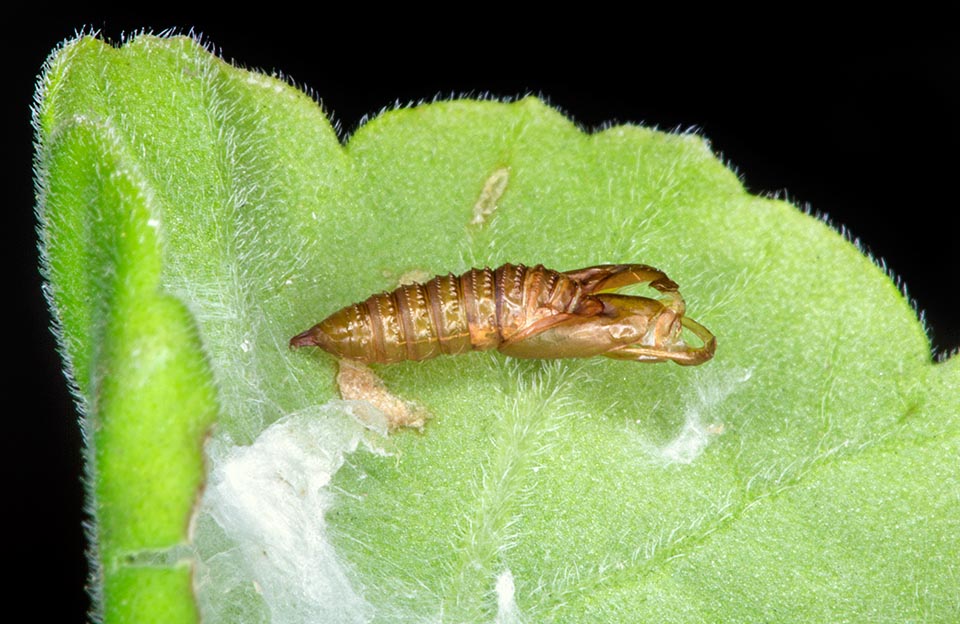
Looking among the leaves, here is the sculptural exuvia of a chrysalis. Its owner has flown away. It thinks the wedding or maybe has already laid © Giuseppe Mazza
The caterpillar is green and is often marked by a more or less accentuated violaceous dorsal line. The chrysalis is attached to a leaf wrapping the lower page with a thick and invisible web of greenish colour. Host plants are the members of the genus Pelargonium.
Since long there is a fierce struggle against this small insect that irreparably damages our flowerbeds, causing ineluctable harm with almost sure death of the plant attacked. It is clear that not all of us can exploit the use of so much valid and powerful pesticides to eradicate since the onset these parasites, as usually can do the nurserymen and the persons specialized in agronomy. We can only limit to the use of pyrethrum products or mixtures that every one of us tries to find out cleverly with various experimentations such as infusions of garlic, of tobacco and even mild detergents. Can be also used products of the so called biological struggle, such as the Bacillus thuringiensis but it seems and is now sure, that we shall have to live forever with this problem, excepting that one day, once all geraniums killed, this nice small butterfly will decide to begin a return trip to its homeland.
→ For general notions about the Lepidoptera please click here.
→ To appreciate the biodiversity within the BUTTERFLIES please click here.
